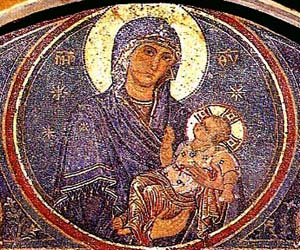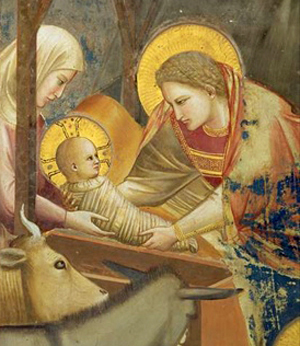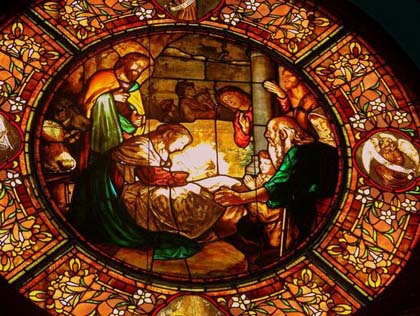 |
Feasts of Our Lord
Birth of Our Lord Jesus Christ
December 25
Prof. Plinio Corrêa de Oliveira
It is Christmas Eve and the Birth of Our Lord Jesus Christ must be the object of our meditation. I suggest that we try to discern the state of spirit of Our Lady on Christmas Night.

What were the thoughts of Our Lady adoring the Child on Christmas night? |
She was already bearing Our Lord within her. She carried Him as in a Tabernacle and had the greatest possible intimacy with him, a profound relationship of soul. Certainly Our Lord had full use of His reason inside the maternal womb. He was able to think from the first instant of His Being, as soon as the Incarnation took place. Not only was He capable of thinking, but also of willing. Therefore, an intense interaction of souls was established between Him and Our Lady that grew continually until the moment of His Birth.
Before the Incarnation, Our Lady had a great union of soul with God and, therefore, a union with the Second Person of the Holy Trinity. But after the Incarnation, she began to have a different kind of union – the union of the God-Man with His Mother. Knowing this, we cannot think that Our Lady had no knowledge whatsoever of her Son until His birth and only entered into contact with Him then for the first time. She already had a very intimate and ardent union of soul with Him.
So, what did Christmas represent for Our Lady?
It is obvious that the moment when Our Lord left the maternal cloister – without damaging her virginity in any way – must have been a very elevated one. That moment when Our Lady brought Christ forth into the world must have been one of an extraordinary manifestation of her jubilance and love for Him, as well as an extraordinary union of soul with Him.

A new joy for Our Lady as she contemplates the features and person of her Son |
Simultaneously, the act of His birth - which included the participation of the Three Persons of the Holy Trinity - was commemorated by all the Angels in Heaven with canticles of joy. The Birth of Our Lord is surely one of the greatest feasts in Heaven and one of the most glorious moments in all History. Thus, we can see how momentous and important this act was for her.
I believe, however, that there was something more that Our Lady would have experienced. She had not yet seen the face of Our Lord. The physical reality is a symbol and expression of the spiritual reality. In the features of the Holy Face of Our Lord, one would be able to perfectly distinguish His flawless soul. His body would be the expression of His soul, united with the Second Person of the Trinity.
Thus contemplating His gaze, His Holy Face and His body, Our Lady acquired a new knowledge of Her Son that increased her understanding of His mentality. She could love Him and be united with Him in this new way, which certainly inspired the adoration she offered Him on Christmas Night.
The human gaze is the most expressive sign of a person’s mentality, but it is not the only one. The mentality is also expressed by the neck, shoulders, hands, feet – above all, by the ensemble. If we consider this, then we can imagine Our Lady contemplating those psychological and supernatural manifestations of Him and, in view of this, profoundly adoring Him.
The iconography of the Renaissance completely deformed one aspect of Our Lord. It presented the Child Jesus as a foolish babe in order to give an idea of His purity. The artists of that period often presented Him as an inexpressive infant without showing any sign of His divine mentality. I cannot think that such a thing is true. On the contrary, I believe that everything we admire in Our Lord as a man – His goodness, balance, distinction, affability and strength, and especially His transcendence – was already manifest in the face and body of the Divine Infant.
All those perfections that made Him a Man superior to all others were expressed for the first time at Christmas and were the object of the adoration of Our Lady and also of St. Joseph, who was there with her and shared that act of adoration as her spouse and the father of the Child Jesus.
We can picture the tenderness, respect, veneration and adoration of St. Joseph as he looked at that Child whom he knew was a Son of the Holy Ghost and Our Lady, but who was legally his Son. It was as his Son that He became the Son of David and fulfilled the prophecies of the Scriptures. Gazing at that Child, he was considering that the Infant was His God and the God of all mankind and, notwithstanding, He was his Son, as the Son of his spouse. We can imagine the act of adoration of St. Joseph when he saw the sanctity of the Divine Infant expressed in His Person and illuminating the entire Cave!

The light of Christmas emanated from the Person of the Divine Infant |
This idea of how His sanctity was expressed in His Person – in His face and body – manifesting the Hypostatic Union of God and Man, this is what we can contemplate on Christmas Night.
There are many holy cards representing the Manger scene with a Christ Child with a foolish face and rays of light emanating from the straw of the Manger. I believe that they are wrong – the light was not coming from the straw, but from the most Holy Face and the Person of the Christ Child.
Perhaps this could be a subject for our meditation on this Christmas Eve and Christmas Day. Let us ask Our Lady and St. Joseph to help us understand this mystery and give us a truly recollected and pious Christmas.


  | | Prof. Plinio Corrêa de Oliveira | |
The Saint of the Day features highlights from the lives of saints based on comments made by the late Prof. Plinio Corrêa de Oliveira. Following the example of St. John Bosco who used to make similar talks for the boys of his College, each evening it was Prof. Plinio’s custom to make a short commentary on the lives of the next day’s saint in a meeting for youth in order to encourage them in the practice of virtue and love for the Catholic Church. TIA thought that its readers could profit from these valuable commentaries.
The texts of both the biographical data and the comments come from personal notes taken by Atila S. Guimarães from 1964 to 1995. Given the fact that the source is a personal notebook, it is possible that at times the biographic notes transcribed here will not rigorously follow the original text read by Prof. Plinio. The commentaries have also been adapted and translated for TIA’s site.
|
Saint of the Day | Home | Books | CDs | Search | Contact Us | Donate

© 2002- Tradition in Action, Inc. All Rights Reserved
|
 |

|